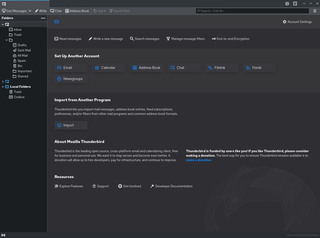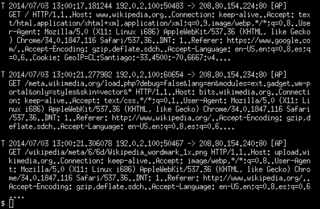
Telnet is an application protocol used on the Internet or local area network to provide a bidirectional interactive text-oriented communication facility using a virtual terminal connection. User data is interspersed in-band with Telnet control information in an 8-bit byte oriented data connection over the Transmission Control Protocol (TCP).

Wake-on-LAN is an Ethernet or Token Ring computer networking standard that allows a computer to be turned on remotely by a network message. The message is usually sent to the target computer by a program executed on a device connected to the same local area network. It is also possible to initiate the message from another network by using subnet directed broadcasts or a WoL gateway service.

An email client, email reader or, more formally, message user agent (MUA) or mail user agent is a computer program used to access and manage a user's email.

A packet analyzer, also known as packet sniffer, protocol analyzer, or network analyzer, is a computer program or computer hardware such as a packet capture appliance, that can intercept and log traffic that passes over a computer network or part of a network. Packet capture is the process of intercepting and logging traffic. As data streams flow across the network, the analyzer captures each packet and, if needed, decodes the packet's raw data, showing the values of various fields in the packet, and analyzes its content according to the appropriate RFC or other specifications.
A virtual private network (VPN) extends a private network across a public network and enables users to send and receive data across shared or public networks as if their computing devices were directly connected to the private network. The benefits of a VPN include increases in functionality, security, and management of the private network. It provides access to resources that are inaccessible on the public network and is typically used for remote workers. Encryption is common, although not an inherent part of a VPN connection.

tcpdump is a data-network packet analyzer computer program that runs under a command line interface. It allows the user to display TCP/IP and other packets being transmitted or received over a network to which the computer is attached. Distributed under the BSD license, tcpdump is free software.
Unix security refers to the means of securing a Unix or Unix-like operating system. A secure environment is achieved not only by the design concepts of these operating systems, but also through vigilant user and administrative practices.
SOCKS is an Internet protocol that exchanges network packets between a client and server through a proxy server. SOCKS5 optionally provides authentication so only authorized users may access a server. Practically, a SOCKS server proxies TCP connections to an arbitrary IP address, and provides a means for UDP packets to be forwarded.

In computer networking, port forwarding or port mapping is an application of network address translation (NAT) that redirects a communication request from one address and port number combination to another while the packets are traversing a network gateway, such as a router or firewall. This technique is most commonly used to make services on a host residing on a protected or masqueraded (internal) network available to hosts on the opposite side of the gateway, by remapping the destination IP address and port number of the communication to an internal host.

Kismet is a network detector, packet sniffer, and intrusion detection system for 802.11 wireless LANs. Kismet will work with any wireless card which supports raw monitoring mode, and can sniff 802.11a, 802.11b, 802.11g, and 802.11n traffic. The program runs under Linux, FreeBSD, NetBSD, OpenBSD, and Mac OS X. The client can also run on Microsoft Windows, although, aside from external drones, there's only one supported wireless hardware available as packet source.

Ettercap is a free and open source network security tool for man-in-the-middle attacks on a LAN. It can be used for computer network protocol analysis and security auditing. It runs on various Unix-like operating systems including Linux, Mac OS X, BSD and Solaris, and on Microsoft Windows. It is capable of intercepting traffic on a network segment, capturing passwords, and conducting active eavesdropping against a number of common protocols. Its original developers later founded Hacking Team.
In the field of computer network administration, pcap is an application programming interface (API) for capturing network traffic. While the name is an abbreviation of packet capture, that is not the API's proper name. Unix-like systems implement pcap in the libpcap library; for Windows, there is a port of libpcap named WinPcap that is no longer supported or developed, and a port named Npcap for Windows 7 and later that is still supported.

Wireshark is a free and open-source packet analyzer. It is used for network troubleshooting, analysis, software and communications protocol development, and education. Originally named Ethereal, the project was renamed Wireshark in May 2006 due to trademark issues.
Omnipeek is a packet analyzer software tool from Savvius, a LiveAction company, for network troubleshooting and protocol analysis. It supports an application programming interface (API) for plugins.

EtherApe is a packet sniffer/network traffic monitoring tool, developed for Unix. EtherApe is free, open source software developed under the GNU General Public License.

ngrep is a network packet analyzer written by Jordan Ritter. It has a command-line interface, and relies upon the pcap library and the GNU regex library.
Justniffer is a TCP packet sniffer. It can log network traffic in a 'standard' or in a customized way. It can also log response times, useful for tracking network services performances . The output format of the traffic can be easily customized. An example written in Python stores the transferred contents in an output directory separated by domains. This means that the transferred files like html, css, javascript, images, sounds, etc. can be saved to a directory.
Xplico is a network forensics analysis tool (NFAT), which is a software that reconstructs the contents of acquisitions performed with a packet sniffer.
The network interface layer, also commonly referred to as the data link layer or link layer, is the lowest layer in the TCP/IP model. This particular layer has several unique security vulnerabilities that can be exploited by a determined adversary.
Sniffing attack in context of network security, corresponds to theft or interception of data by capturing the network traffic using a packet sniffer. When data is transmitted across networks, if the data packets are not encrypted, the data within the network packet can be read using a sniffer. Using a sniffer application, an attacker can analyze the network and gain information to eventually cause the network to crash or to become corrupted, or read the communications happening across the network.









